#great Himalaya
Text
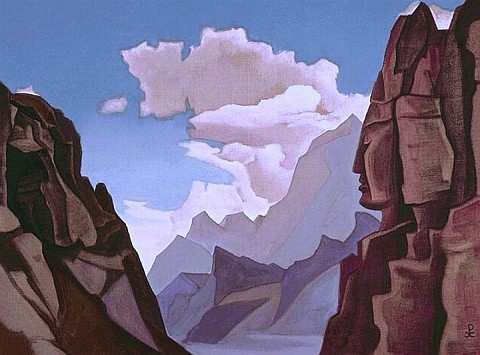
« The Great Spirit Of The Himalayas » by Nicholas Roerich
#tempera painting#tempera paintings#canvas#tempera on canvas#Nicholas Roerich#roerich#art#artwork#painting#paintings#landscapes#landscape#landscape art#mountainscapes#mountainscape#mountains#nature#blues#whites#pinks#purples#browns#sculptures#monument#himalayas#clouds#sky#skies#spirit#great spirit
4 notes
·
View notes
Text
If only I could spend sitting right there and finishing all my TBR lists.

#lakeview#nature#mountains#travel#wanderlust#sky#forest#aesthetics#photographers on tumblr#naturfotografie#great lakes#india#himalayas#himachal pradesh#desiblr#desi tumblr#desi dark academia#desi aesthetic#spring#blooming panic
3 notes
·
View notes
Text
Bodhisattvas – Selfless Saviors of Mahayana Buddhism | Ancient Origins
Bodhisattvas – Selfless Saviors of Mahayana Buddhism | Ancient Origins
https://www.ancient-origins.net/myths-legends-asia/bodhisattvas-0013525

View On WordPress
#300 BC#400 AD#483 BC#563 BC#Bodhisattva#Brahmin#Buddha Amitapha#Buddha Dipankara#Buddha Kannon#Buddha Shakyyamuni#Buddhahood#China#Dharma#Four Great Bodhisattvas#Himalayas#India#Japan#Jatakas#Lotus#Lotus Sutra#Mahayana Buddhism#Sanskrit#Siddhartha Gautama#Sumedha#Taoism#Theravada Buddhism#Tibet
3 notes
·
View notes
Text
Review: Kim - by Rudyard Kipling
‘Kim’ is recognised as the greatest work of famous author Rudyard Kipling. This is a cult novel especially in espionage circles. It is fiction but documents the widely popular Great Game between the British Empire and Tsarist Russia, a clandestine cat and mouse conflict between the two powers fought out on in British India and the border territories which separated the two great powers. Indeed…

View On WordPress
#British Empire#Buddhism#buddhist#Chela#enlightenment#espionage#Geography#Great Game#himalayas#Hindi#Hindu#Imperial India#india#Islam#KGB#Kim#kim philby#Kipling#lama#Little Friend of the World#mi6#Muslim#Musselman#Queen Victoris#Raj#religion#Rudyard Kipling#russia#Sahib#Soviet Union
2 notes
·
View notes
Text
Dear younger self
I am at a age where I feel I should have followed my heart and done what makes me want more in my heart.
Days are being numbered after every 24 hours in a quick wake.
Go travel around
Eat the most delicious food
Take care always be thankful

#dreams#travellersnotebook#himalayas#hills#once more with feeling#daily verse#great things#kodak#my life#northeastdiaries#capture#once upon a dream#questions
2 notes
·
View notes
Text
Exploring the Enchantment: Kashmir Great Lakes Trek
Unveiling the Beauty
Introduction
Embark on an unforgettable journey through the mesmerizing landscapes of the Indian Himalayas with the Kashmir Great Lakes Trek. This legendary trek offers a unique opportunity to immerse yourself in the natural splendor of the Kashmir Valley, where pristine alpine lakes, lush meadows, and majestic peaks await.
Discovering Kashmir Great Lakes
Nestled amidst the snow-capped peaks of the Pir Panjal Range, the Kashmir Great Lakes Trek takes trekkers on a spellbinding adventure through some of the most picturesque scenery in the world. From the serene waters of Gangbal Lake to the pristine beauty of Tarsar Lake, each destination on this trek is a testament to the breathtaking wonders of nature.
Trekking Experience
Challenging Yet Rewarding
The Kashmir Great Lakes Trek offers a perfect blend of challenge and reward for trekkers of all levels. With its rugged terrain, steep ascents, and high-altitude passes, it demands physical endurance and mental resilience. However, the awe-inspiring vistas and unparalleled beauty that await at every turn make every step worth the effort.
Mesmerizing Landscapes
As you trek through the Kashmir Valley, you'll be treated to a feast for the senses at every turn. From verdant meadows carpeted with wildflowers to towering peaks that pierce the sky, the diversity of landscapes on this trek is truly awe-inspiring. Be sure to have your camera ready to capture the breathtaking scenery that unfolds before you.
Wildlife Encounters
Keep your eyes peeled for glimpses of Himalayan wildlife as you make your way through the pristine wilderness of the Kashmir Valley. From the elusive snow leopard to the graceful Himalayan ibex, the region is home to a diverse array of fauna that adds to the magic of the trekking experience.
Practical Tips
Essential Gear
Before embarking on the Kashmir Great Lakes Trek, ensure you are well-prepared with the necessary gear and equipment. This includes sturdy trekking boots, warm clothing, a waterproof jacket, a sleeping bag, and plenty of snacks and water to sustain you throughout the journey.
Permits and Regulations
Obtaining the necessary permits from the Jammu & Kashmir Tourism Department is essential for trekking in the region. Additionally, familiarize yourself with local regulations and guidelines to ensure a safe and enjoyable trekking experience.
Kashmir Great Lakes Trek offers a rare opportunity to embark on a journey of discovery and adventure through some of the most breathtaking scenery in the world. From the serenity of alpine lakes to the majesty of snow-capped peaks, every moment on this trek is a testament to the unparalleled beauty of the Kashmir Valley.
0 notes
Text
Hey All,
I've been away for some time, as we've been working really hard on something quite exciting:
let me present to you the world's first ever global ocean drainage basin map that shows all permanent and temporary water flows on the planet.

This is quite big news, as far as I know this has never been done before. There are hundreds of hours of work in it (with the data + manual work as well) and it's quite a relief that they are all finished now.
But what is an ocean drainage basin map, I hear most of you asking? A couple of years ago I tried to find a map that shows which ocean does each of the world's rivers end up in. I was a bit surprised to see there is no map like that, so I just decided I'll make it myself - as usual :) Well, after realizing all the technical difficulties, I wasn't so surprised any more that it didn't exist. So yeah, it was quite a challenge but I am very happy with the result.
In addition to the global map I've created a set of 43 maps for different countries, states and continents, four versions for each: maps with white and black background, and a version for both with coloured oceans (aka polygons). Here's the global map with polygons:
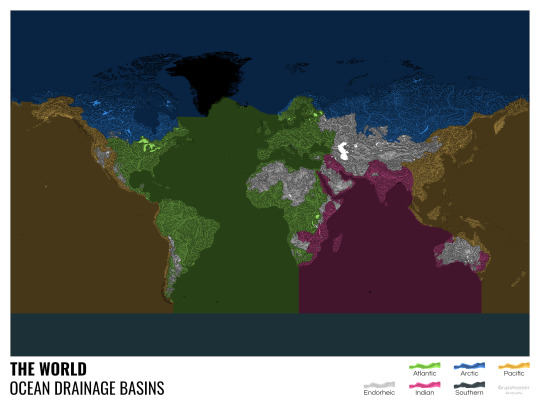
I know from experience that maps can be great conversation starters, and I aim to make maps that are visually striking and can effectively deliver a message. With these ocean drainage basin maps the most important part was to make them easily understandable, so after you have seen one, the others all become effortless to interpret as well. Let me know how I did, I really appreciate any and all kinds of feedback.
Here are a few more from the set, I hope you too learn something new from them. I certainly did, and I am a geographer.
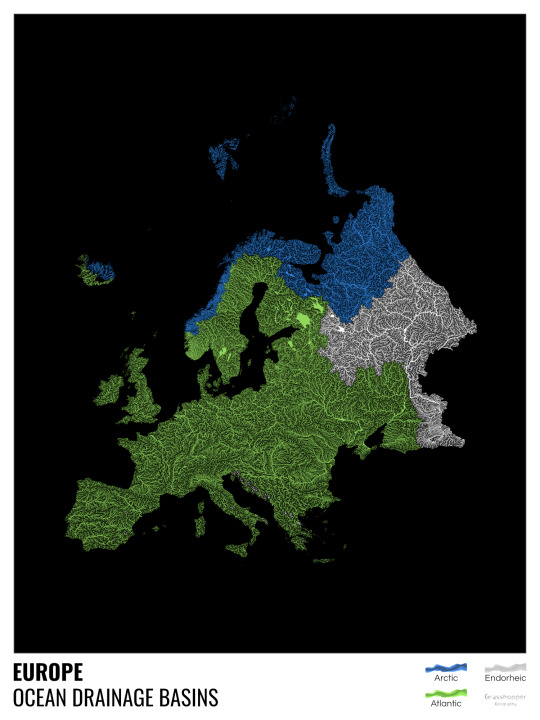
The greatest surprise with Europe is that its biggest river is all grey, as the Volga flows into the Caspian sea, therefore its basin counts as endorheic.
An endorheic basin is one which never reaches the ocean, mostly because it dries out in desert areas or ends up in lakes with no outflow. The biggest endorheic basin is the Caspian’s, but the area of the Great Basin in the US is also a good example of endorheic basins.
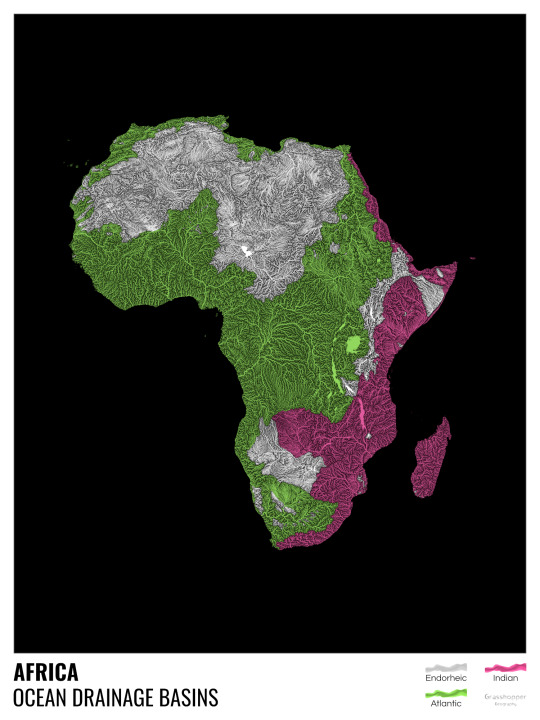
I love how the green of the Atlantic Ocean tangles together in the middle.
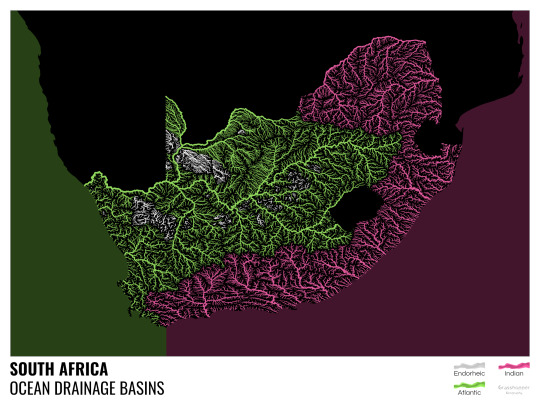
No, the dividing line is not at Cape Town, unfortunately.

I know these two colours weren’t the best choice for colourblind people and I sincerely apologize for that. I’ve been planning to make colourblind-friendly versions of my maps for ages now – still not sure when I get there, but I want you to know that it’s just moved up on my todo-list. A lot further up.

Minnesota is quite crazy with all that blue, right? Some other US states that are equally mind-blowing: North Dakota, New Mexico, Colorado, Wyoming. You can check them all out here.
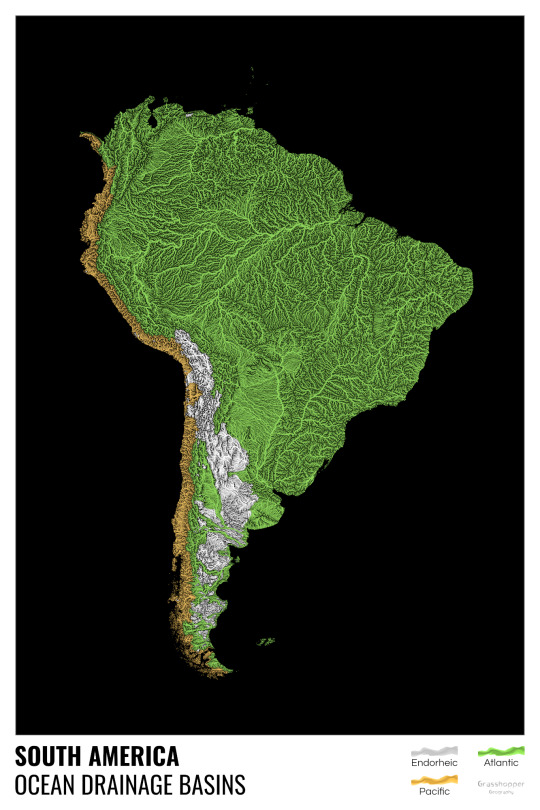
Yes, most of the Peruvian waters drain into the Atlantic Ocean. Here are the maps of Peru, if you want to take a closer look.
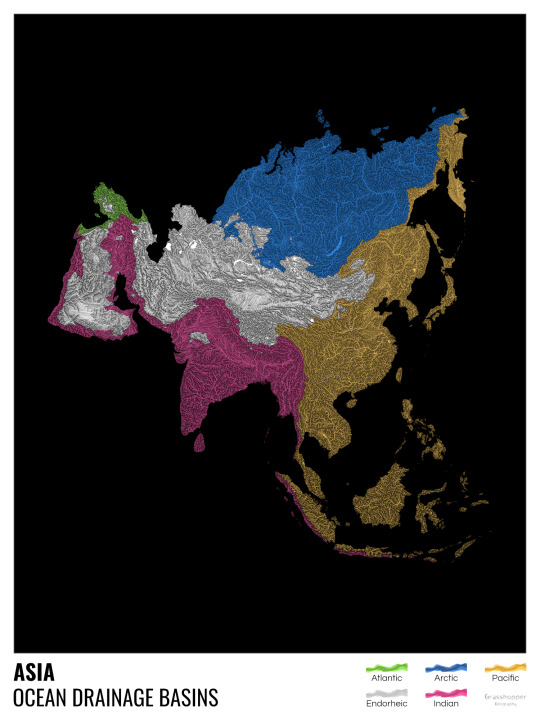
Asia is amazingly colourful with lots of endorheic basins in the middle areas: deserts, the Himalayas and the Caspian sea are to blame. Also note how the Indonesian islands of Java and Sumatra are divided.
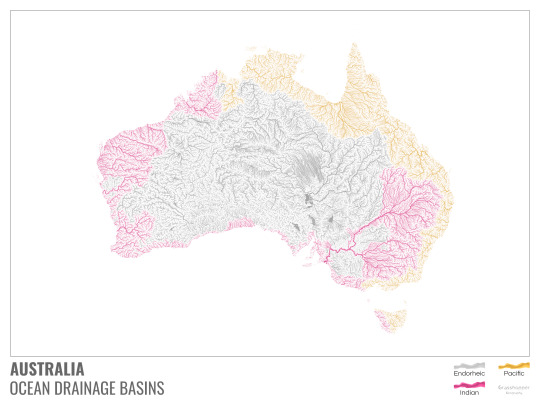
I mentioned earlier that I also made white versions of all maps. Here’s Australia with its vast deserts. If you're wondering about the weird lines in the middle: that’s the Simpson desert with its famous parallel sand dunes.
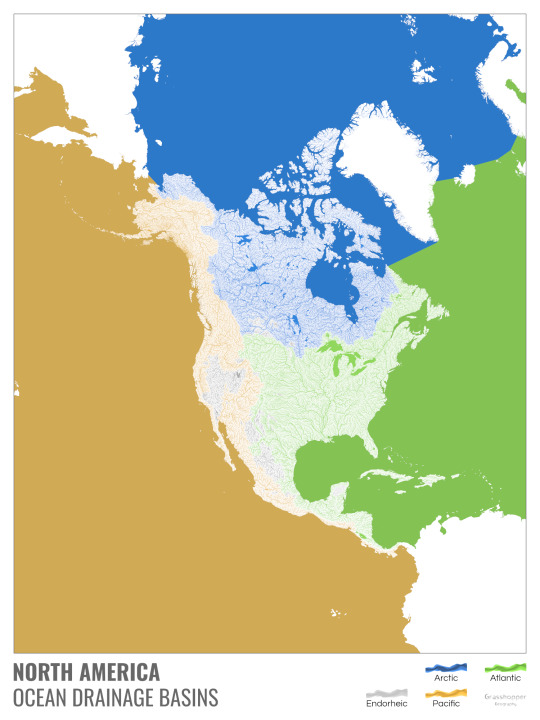
North America with white background and colourful oceans looks pretty neat, I think.

Finally, I made the drainage basin maps of the individual oceans: The Atlantic, the Arctic, the Indian and the Pacific. The Arctic is my favourite one.
I really hope you like my new maps, and that they will become as popular as my river basin maps. Those have already helped dozens of environmental NGOs to illustrate their important messages all around the world. It would be nice if these maps too could find their purpose.
#maps reimagined#geography#cartography#maps#my art#rivers of the world#ocean drainage basins#ocean maps#river maps
16K notes
·
View notes
Text
Masterplan 2050: tien soorten, acht gebieden, één doel
In het bijzijn van medewerkers, onderzoekers en zakenpartners heeft Diergaarde Blijdorp vandaag het Masterplan 2050 officieel gepresenteerd. Al enkele jaren is het park achter de schermen bezig met een fundamentele hervorming: van dierentuin met natuurbehoudsagenda naar natuurbeschermingsorganisatie met een levende have. Het nieuwe motto: Beleven, Beschermen, Blijdorp!
Daad bij woord
In 2020…

View On WordPress
#Amoer#Annam-waterschildpad#Antilliaanse Leguaan#Arctica#Atlantische Oceaan#Australië#Aziatische Olifanten#Blijdorper Bende#Caraïbisch Café#Chinese Tuin#Diergaarde Blijdorp#Doktersvissen#Dwergnijlpaarden#Europa#Gierenrots#Great Barrier Reef#Hart van Afrika#Himalaya#Kroeskoppelikanen#Maleise Bosrand#Moeraswallaby#Natuurbehoudscentrum#Noord-Amerika#Noordzee#Oceanium#Prairie#Rivièrahal#Rode Panda#Rüppels Gieren#Savanne
0 notes
Text
Srinagar Tour Packages
Ruled largely by long expanses of Scenic Mountains, the Valley of Kashmir covers an area of 224,739 sq km. The Great Himalaya range parts Kashmir from Ladakh, whereas, the Pir Panjal range limits it as a valley by drawing a border and parting it from the northern plains. Therefore expect an impressive sensual landscape that cherishes the valley as an ideal destination for Kashmir Holdiay.
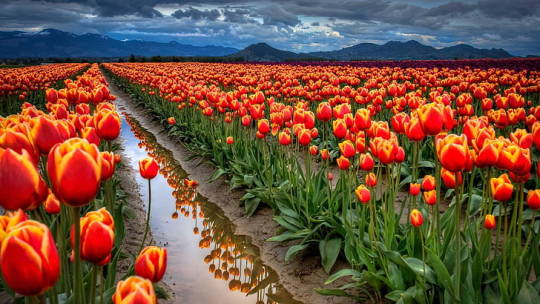
#long expanses of Scenic Mountains#the Valley of Kashmir covers an area of 224#739 sq km#The Great Himalaya range parts Kashmir#Ladakh#the Pir Panjal#a valley by drawing a border and parting it from the northern plains.#Kashmir Holdiay.
0 notes
Text

Trekking and Camping-jkone.net
The scenery along the way is breath-taking. It’s not just about seeing the snow-capped mountains, but also taking in all the other sights, like colorful flowers and butterflies. Plan Trekking And Camping with Jkone.net for lifetime experience.
#Trekking and Camping#jkone.net#Camping In Sonmarg#climbing#kashmir great lakes trek solo#trekking in nepal#himalayas#hiking#backpacking#trekking benefits
0 notes
Text
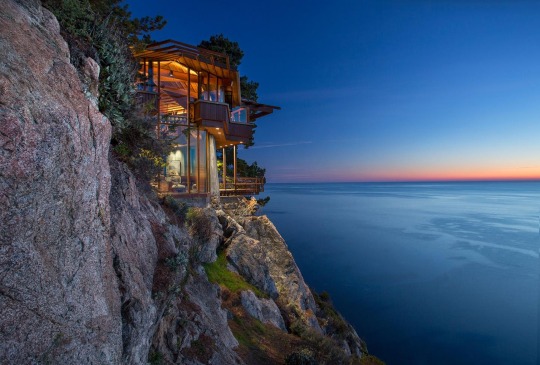

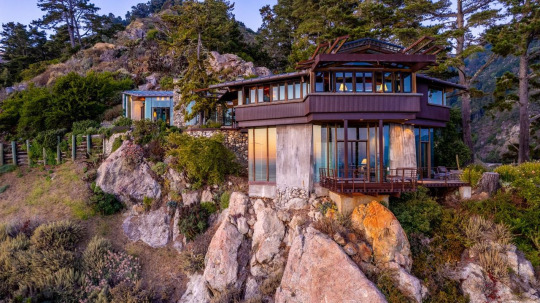
Spectacular 1968 home perched on a rocky cliff in Big Sur, California. "Taktsang Big Sur" was originally inspired by a monastery high in the Himalayas of Bhutan, and later extensively remodeled by Big Sur architect Mickey Muennig. 2bds, 2ba, $25M.
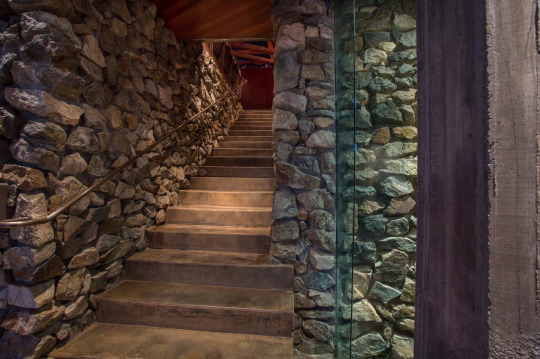
Really, for $25M, I would rather have something like this than some fussy estate.
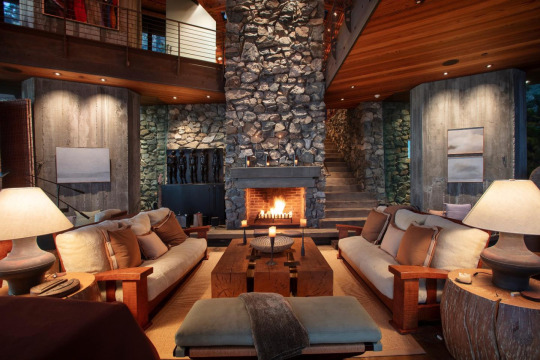

Very comfy and cozy with beautiful views inside and out.

Dining area with a view, plus a door to the patio.
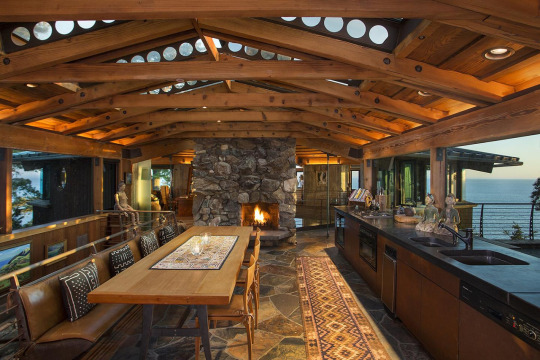
Beautiful large kitchen with a fireplace and a view. Look at the unique ceiling.
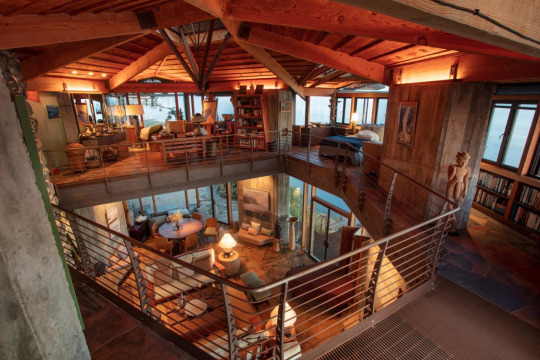
On the 2nd level there's a great ceiling and family areas, plus a view of the main floor from the mezzanine.

The view is even better on the upper floor.


The open primary bedroom on the mezzanine.
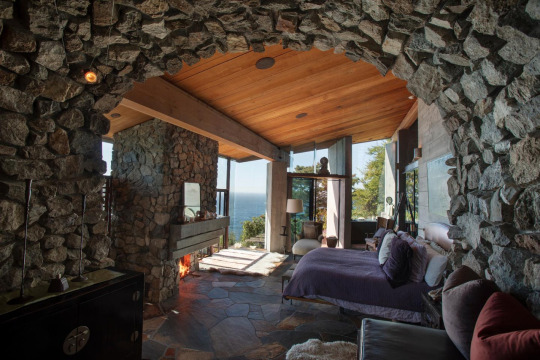
There's a cave-like entrance to this bedroom with a fireplace. It looks like a covered outdoor patio.

Bath with a view.

Isn't this wonderful. Almost feels like you're on the deck of a ferry boat.
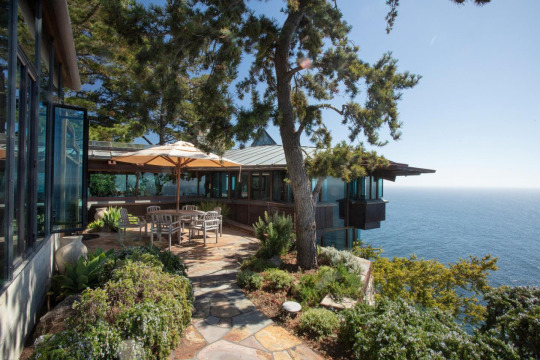
The 1.50 acre property has fabulous gardens and outdoor spaces.

Love these lighted stairs.

They lead to this sitting area above the sea.
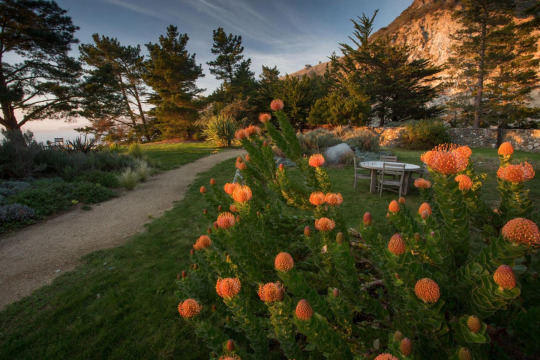
So pretty, isn't it?

What a cool house.
213 notes
·
View notes
Photo
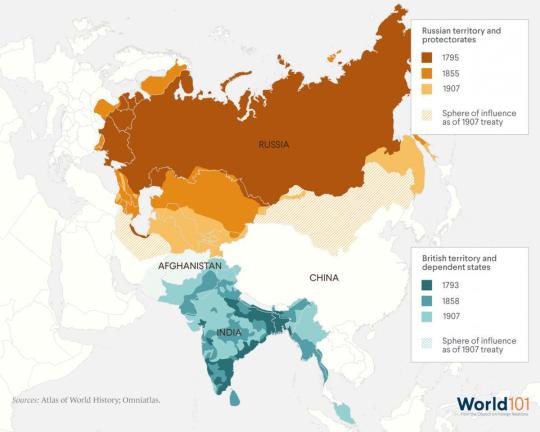
The Great Game: British and Russians in Asia.
The Great Game was a rivalry between the 19th-century British and Russian Empires over influence in Central Asia, primarily in Afghanistan, Persia, and Tibet. The two colonial empires used military interventions and diplomatic negotiations to acquire and redefine territories in Central and South Asia. Russia conquered Turkestan, and Britain expanded and set the borders of British colonial India. By the early 20th century, a line of independent states, tribes, and monarchies from the shore of the Caspian Sea to the Eastern Himalayas were made into protectorates and territories of the two empires.
97 notes
·
View notes
Text

[Image above: Gobajo statue with a crown of elephant, the largest animal on land, on its head. One of the Eight Legions.]
Legends of the humanoids
Reptilian humanoids (10)
The Eight Great Dragon Kings – Dragon tribes who listened to the Buddha's teachings.
They are the eight kings of the dragon races, who belong to the Eight Legions of Buddhist dieties. They protect the Buddha Dharma.
In Buddhism, Nagaraja (lit. 'king of the nagas') in Hindu mythology was incorporated as various dragon deities, including the Eight Great Dragon Kings.
Nagarajas are supernatural beings who are kings of the various races of Nagas, the divine or semi-divine, half-human, half-serpent beings that reside in the netherworld (Patala), and can occasionally take human form. The duties of the Nāga Kings included leading the nagas in protecting the Buddha, other enlightened beings, as well as protecting the Buddha Dharma.
Some of the most notable Nagarajas occurring in Buddhist scriptures are Virupaksa, Mucalinda, Dhrtarastra, and the following Eight Great Dragon Kings:
Nanda (Ananta, lit. joy): Ananta and Upananda were brother dragon kings who once fought against the Dragon King Sagara.
Upananda (lit. sublime joy): Brother of Nanda. Together with King Nanda, he protected the country of Magadha, ensuring that there was no famine, and when the Buddha descended, he sent rain to bless it and attended all the sittings where he preached. After the Buddha's death, he protected the Buddha Dharma forever.
Sagara (lit. 'Great Sea'): king of the Dragon Palace. King of the Great Sea Dragon.The 8-year-old Dragon Lady in the Lotus Sutra was the third princess of this Dragon King and was known as the Zennyo Ryuo (lit. "goodness woman dragon-king").
Vasuki (lit.'treasure'): sometimes referred to as the Nine-Headed Dragon King with the 'nine' meaning the extremity of yang and extremely large and powerful in number. Thus, he was thought of as the "Nine-Headed Dragon King". In the original legend, he was seldom called the 'Many-headed Dragon King' because there were a thousand of heads. Originally, he protected Mt. Meru (Ref1) and took tiny dragons to eat.
Takshaka (lit. ‘polyglot' or 'visual poison'): When this dragon is angrily stared at, the person is said to die out. From the Golden Light Sutra, the Seven-faced Tennyo is said to be the daughter of this Dragon King.
Anavatapta (lit. "cool and free from heat"): was said to live in the mythical pond in the northern Himalayas, Anuttara (lit. "free from heat"), which emitted great rivers in all directions to moisten the human continent of Jambudvīpa. A pond that stretches for approx. 3142 km, the banks of the pond were said to be made of four treasures, including gold, silver and others. This Dragon King was venerated as an incarnation of a Bodhisattva.
Manasvin (lit. 'giant' or 'great power'): When Asura (See2 & See3) attacked Kimi Castle with seawater, he twisted himself around and pushed the water back. Kimi Castle is the castle in Trayastrimsa at the top of Mt. Meru, where Sakra (Indra:Ref) resides.
Uppalaka (Utpala: lit. blue lotus flower): blue lotus flower dragon king. He is said to dwell in a pond that produces blue lotus flowers. In India, the shape of the petals and leaves is used metaphorically to represent the eye, especially the blue water lily (nilotpala), which is a metaphor for a beautiful eye. In Buddhism, the Buddha's eyes are considered to be dark blue (nila), one of the 32 phases (ref4) and 80 kinds of favourites (ref5), "eye colour ".
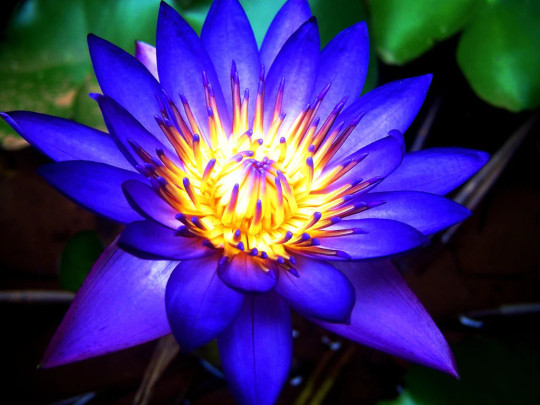
伝説のヒューマノイドたち
ヒト型爬虫類 (10)
八大龍王〜釈迦の教えに耳を傾けた龍族
彼らは、天龍八部衆に所属する龍族の八柱の王である。仏法を守護している。
仏教では、インド神話におけるナーガラジャ (ナーガの諸王の意) が、八大龍王をはじめさまざまな龍神として取り入れられた。ナーガラージャとは、冥界 (パタラ) に住む神または半神半人の蛇のような存在であるナーガ (参照) の様々な種族の王であり、時には人間の姿をとることもある超自然的な存在のこと。
ナーガ王たちの任務は、ナーガ��ちを率いて仏陀や他の悟りを開いた存在たちを守護し、仏陀の教えを守ることであった。
仏教経典に登場するナーガラージャの中で最も有名なものには、ヴィルパクサ、ムカリンダ、ドルタラストラ、そして以下の八大龍王たちである:
難陀 (アナンタ:歓喜の意): 難陀と跋難陀は兄弟竜王で娑伽羅 (サーガラ:大海の意) 龍王と戦ったことがあった。
跋難陀 (ウパナンダ: 亜歓喜の意): 難陀の弟。難陀竜王と共にマガダ国を保護して飢饉なからしめ、また釈迦の降生の時、雨を降らしてこれを灌ぎ、説法の会座に必ず参じ、釈迦仏入滅の後は永く仏法を守護した。
娑伽羅 (サーガラ:大海の意): 龍宮の王。大海龍王。法華経に登場する八歳の龍女はこの龍王の第三王女で「善女龍王」と呼ばれた。
和修吉 (ヴァースキ: 宝有の意):「九頭龍王」と呼ばれることもある。「九」は陽の極まりを意味し、数が非常に多く強力であることから、「九頭龍王」と考えられた。そのため、彼は「九頭の龍王」と考えられていた。元の伝説では、頭が千個あったため、稀に「多頭龍王」と呼ばれることもあった。もともとは、須弥山(参照1)を守り、細龍を捕らえて食べていた。
徳叉迦 (タクシャカ: 多舌、視毒の意): この龍が怒って凝視された時、その人は息絶えるといわれる。身延鏡と金光明経から七面天女は、この龍王の娘とされている。
阿那婆達多 (アナヴァタプタ: 清涼、無熱悩の意): ヒマラヤ山脈北部にある神話上の池、阿耨達池 (無熱悩池) に住み、四方に大河を出して人間の住む大陸 閻浮提 (えんぶだい) を潤していた。 全長800里 (約3142 km)にも及ぶ池の岸辺は金・銀などの四宝よりなっていたという。この龍王は菩薩の化身として崇められていた。
摩那斯 (マナスヴィン: 大身、大力の意): 阿修羅(参照2 & 参照3)が海水をもって喜見城を侵したとき、身をよじらせて海水を押し戻したという。喜見城とは須弥山の頂上の 忉利天にある 帝釈天 (梵: インドラ参照) の居城。
優鉢羅 (ウッパラカ: 青蓮華の意): 青蓮華龍王。青蓮華を生ずる池に住まうという。インドでは花弁や葉などの形状を比喩的に眼を現すことに用いるが、特に青睡蓮(nilotpala)は美しい眼に喩えられる。仏教では仏陀の眼は紺青色(nila)とされ、三十二相八十種好(参照4)の一つ「眼色如紺青相」となっている。
#eight dragon kings#dragon#humanoids#legendary creatures#hybrids#hybrid beasts#cryptids#therianthropy#legend#mythology#folklore#nature#art#reptilian#snake
91 notes
·
View notes
Text
The Landscapes Of India






Welcome to the varied landscapes of India, my dear friends starting with the loftiest mountain range in the world called the Himalayas in the North to the grasslands of India in the South of Himalayan foothills, also spread across parts of central & western India.
We also have two big deserts in India.
A sandy, yellow desert called the Thar Desert/The Great Indian Desert in the North Western State of Rajasthan.
Then a salty desert or White Desert called the Great Rann of Kutch located in the western state of Gujarat.
The gorgeous backwaters of India are mostly found in the South Western state of India called Kerala.
Similarly the lush green tea gardens at Munnar is also located in the state of Kerala in South India.
The coastal areas with its gorgeous beaches spread in the West, East & South of India can be explored all round the year for some adventurous & fun filled activities.
Happy weekend, my dear friends & see you soon 🙌 🤗
#incredibleindia#travelblogger#travel destinations#bharat#traveller#destination#travelphotography#travel video#travels#travel blog#travelpics#travel india#travel photo#travelling#travelblog#tourist#tourism#india#outdoor#adventures
80 notes
·
View notes
Text
Российский ювелир Ильги�� Фазулзянов из украшений создает предметы искусства.
Russian jeweler Ilgiz Fazulzyanov creates art objects from jewelry.

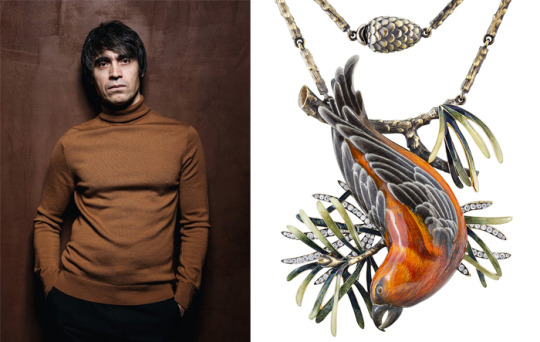
Ильгиз Фазулзянов — единственный российский ювелир и эмальер, получивший громкое международное признание. Он дважды обладатель ювелирного «Оскара», гран-при конкурса International Jewellery Design Excellence Award в Гонконге, сотрудничал с легендарным часовым домом Bovet и Van Cleef&Arpels, его галереи открыты в Москве и Париже.
Его коллекция «Великие вершины мира» — это пять колец, посвященных пяти известным всем с детства горам- это драгоценно-эмалевые миниатюры Фудзиямы, Килиманджаро, Арарата,Гималаи и Везувия.
Ilgiz Fazulzyanov is the only Russian jeweler and enameller who has received great international recognition. He is a two-time winner of the jewelry Oscar, the Grand Prix of the International Jewelery Design Excellence Award in Hong Kong, has collaborated with the legendary watch house Bovet and Van Cleef&Arpels, his galleries are open in Moscow and Paris.
His collection “Great Peaks of the World” consists of five rings dedicated to five mountains known to everyone since childhood - these are precious enamel miniatures of Fuji, Kilimanjaro, Ararat, the Himalayas and Vesuvius.

Кольцо Килиманджаро-золото, эмаль, бриллианты, сапфиры, танзаниты. Ring of Kilimanjaro-gold, enamel, diamonds, sapphires, tanzanites.

Кольцо Фудзияма -золото, эмаль, бриллианты, лунный камень. Ring of Fuji - gold, enamel, diamonds, moonstone.

Кольцо "Гималаи"-золото, эмаль, бриллианты. Ring "Himalayas"-gold, enamel, diamonds.

Кольцо "Везувий"-золото, эмаль, опал. Ring "Vesuvius"-gold, enamel, opal.

Кольцо "Арарат"золото, эмаль, бриллианты, сапфиры, танзаниты. Ring "Ararat" gold, enamel, diamonds, sapphires, tanzanites.
Сегодня Ильгиз Фазулзянов - один из немногих мастеров в мире, в совершенстве владеющий всеми известными ювелирными техниками: филиграни, гравировки, чеканки и эмали и сочетающий их самым неожиданным и оригинальным образом. Мастер использует яркие эмали для создания цветовых эффектов и реалистичного изображения природы в стилистике ар деко и ар нуво.
Today Ilgiz Fazulzyanov is one of the few craftsmen in the world who is fluent in all known jewelry techniques: filigree, engraving, embossing and enamels and combines them in the most unexpected and original way. The master uses bright enamels to create color effects and realistic images of nature in the Art Deco and Art Nouveau style.

Брошь-подвеска «Маки». Brooch pendant “Poppies”.

Браслет “Ласточки”, золото, эмаль, горный хрусталь, бриллианты. Bracelet “Swallows”, gold, enamel, rock crystal, diamonds.
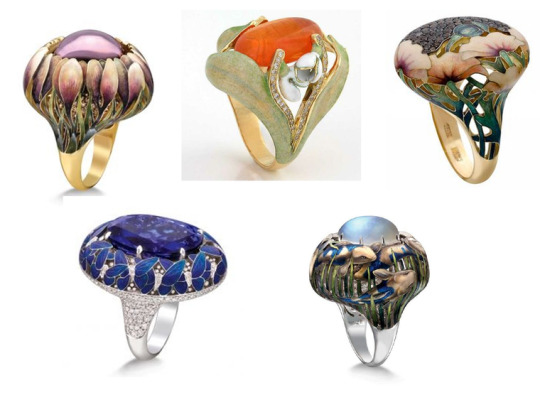

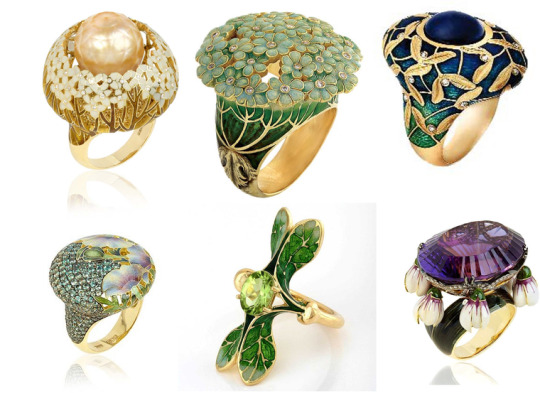


Коллекции драгоценных колец вдохновленные природой. Collections of precious rings inspired by nature.
А также чудесные серьги, колье, броши и подвески в которых нашли свое отражение птицы, рыбы, бабочки. And also wonderful earrings, necklaces, brooches and pendants in which birds, fish, and butterflies are reflected.




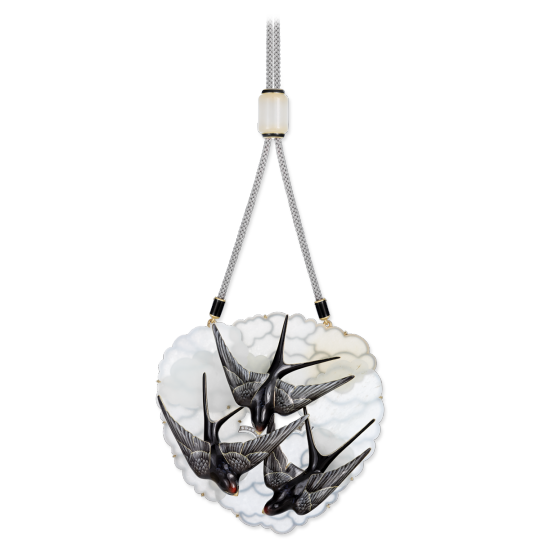
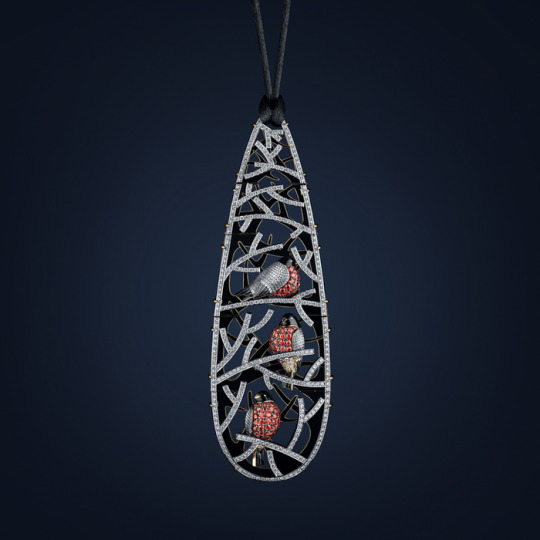




Источник:/www.livemaster.ru/topic/1786805-sovremennyj-modern-ilgiza-fazulzyanova, /antiquesalon.ru/news/476-yuvelirnyie-ukrasheniya-ilgiza-fazulzyanova.html, /lomovskaya.livejournal.com/1850827.html, /pikabu.ru/story/yemotsionalnyie_ukrasheniya_ilgiz_fazulzyanov_7680435, /dzen.ru/a/Y429SAZm_QjwrixG, //www.kommersant.ru/doc/3587235, /moskvichmag.ru/lyudi/yuvelir-ilgiz-fazulzyanov-lyubovatsya-hotyat-bolshe-chem-pokupat/.
#ювелир#Ильгиз Фазулзянов#драгоценности#украшения#золото#бриллианты#самоцветы#кольцо#серьги#браслет#брошь#колье#jewelry#jeweler#Ilgiz Fazulzyanov#gold#diamonds#gemstone#ring#earrings#bracelet#brooch#necklace
69 notes
·
View notes
Text
Planting trees does not necessarily mean a forest is being restored.
---
But efforts to increase global tree cover to limit climate change have skewed towards erecting plantations of fast-growing trees. The reasons are obvious: planting trees can demonstrate results a lot quicker than natural forest restoration. This is helpful if the objective is generating a lot of timber quickly or certifying carbon credits which people and firms buy to supposedly offset their emissions. [...] [I]ll-advised tree planting can unleash invasive species [...]. For more than 200 years India has experimented with tree plantations, offering important lessons about the consequences different approaches to restoring forests have on local communities and the wider environment. This rare long-term perspective should be heeded [...].
Britain extended its influence over India and controlled much of its affairs [...] from the mid-18th century onwards. Between 1857 and 1947, the Crown ruled the country directly and turned its attention to the country’s forests. Britain needed great quantities of timber to lay railway sleepers and build ships in order to transport the cotton, rubber and tea it took from India.
Through the Indian Forest Act of 1865, forests with high-yielding timber trees such as teak, sal and deodar became state property. To maximise how much timber these forests yielded, British colonial authorities restricted the rights of local people to harvest much beyond grass and bamboo. [...] Meanwhile plantations of teak (Tectona grandis), a species well adapted to India’s hot and humid climate and a source of durable and attractive timber, spread aggressively. [...]
---
[G]rasslands and open scrub forest gave way to teak monocultures.
Eucalyptus and other exotic trees which hadn’t evolved in India were introduced from around 1790. British foresters planted pines from Europe and North America in extensive plantations in the Himalayan region as a source of resin and introduced acacia trees from Australia for timber, fodder and fuel.
One of these species, wattle (Acacia mearnsii), first introduced in 1861 with a few hundred thousand saplings, was planted in the Nilgiris district of the Western Ghats. This area is what scientists all a biodiversity hotspot – a globally rare ecosystem replete with species. Wattle has since become invasive and taken over much of the region’s mountainous grasslands.
Similarly, pine has spread over much of the Himalayas and displaced native oak trees while teak has replaced sal, a native hardwood, in central India. Both oak and sal are valued for fuel, fodder, fertiliser, medicine and oil. Their loss [...] impoverished many.
---
India’s national forest policy [...] aims for trees on 33% of the country’s area. Schemes under this policy include plantations consisting of a single species such as eucalyptus or bamboo which grow fast and can increase tree cover quickly, demonstrating success according to this dubious measure. Sometimes these trees are planted in grasslands and other ecosystems where tree cover is naturally low. The result is that afforestation harms rural and indigenous people who depend on these ecosystems [...].
In the Kachchh grasslands of western India communities were able to restore grasslands by removing the invasive gando bawal (meaning “mad tree”) first introduced by British foresters in the late 19th century. [...]
The success of forest restoration efforts cannot be measured by tree cover alone. The Indian government’s definition of “forest” still encompasses plantations of a single tree species, orchards and even bamboo, which actually belongs to the grass family. This means that biennial forest surveys cannot quantify how much natural forest has been restored, or convey the consequences of displacing native trees with competitive plantation species or identify if these exotic trees have invaded natural grasslands which have then been falsely recorded as restored forests. [...]
Planting trees does not necessarily mean a forest is being restored. And reviving ecosystems in which trees are scarce is important too.
---
Text by: Dhanapal Govindarajulu. "India was a tree planting laboratory for 200 years - here are the results." The Conversation. 10 August 2023. [Bold emphasis, some paragraph breaks/contractions, and italicized first line in this post added by me.]
141 notes
·
View notes